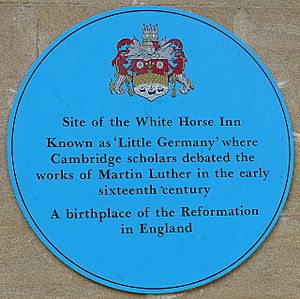White Horse Tavern, Cambridge facts for kids
The White Horse Tavern or White Horse Inn was a famous meeting spot in Cambridge, England. People say that English Protestant reformers met there from 1521 onwards. They supposedly discussed new ideas from Martin Luther, a key figure in the Protestant Reformation.
The historian Geoffrey Elton said that the university teachers who met there were called "Little Germany". This was because they talked about Luther's ideas, which came from Germany.
However, some experts are not sure if these meetings really happened. The main source for this story is John Foxe's book, Foxe's Book of Martyrs. There isn't much other proof. Gergely M Juhász calls Foxe's story "unsubstantiated," meaning it's not proven. Alec Ryrie calls it "the stubborn legend of the White Horse Inn."
Who Met There?
According to John Foxe, many important people attended these meetings. These included Thomas Cranmer, who later became a very important church leader (the Archbishop of Canterbury). Also, Hugh Latimer, who became the Bishop of Worcester, was said to be there.
Other reformers mentioned by Foxe include Robert Barnes, Thomas Bilney, Miles Coverdale, Matthew Parker, William Tyndale, Nicholas Shaxton, John Rogers, and John Bale. Some people who later disagreed with the reformers, like Stephen Gardiner, were also supposedly part of the group. Gardiner later became the Bishop of Winchester.
However, David Daniell, who wrote about William Tyndale, points out a problem. Not all these men were in Cambridge at the same time. He says there's little proof that they were ever together in the pub.
Historian MacCulloch also has doubts about Thomas Cranmer being part of the group. He says that later supporters of Cranmer might have wanted to connect him to these famous meetings. But Foxe's book doesn't list Cranmer's college (Jesus College) as a place where regulars came from.
Even so, many agree that Cambridge was a key place for discussing Luther's ideas. These ideas were about "justification by faith," meaning that people are saved by their faith in God.
Where Was It?
The White Horse Tavern was located near King's Lane in Cambridge. This is west of King's Parade. The pub existed as early as 1455.
It was torn down in 1870. This happened when King’s College built its Scott’s Building. Today, a Blue Plaque marks the spot where the pub once stood. You can find it on the wall where King’s Parade meets Trumpington Street.


